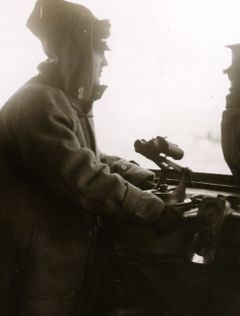Difference between revisions of "Mechanical Aid-to-Spotter Mark II"
(Redirected page to Mechanical Aid-to-Spotter#Mark II) |
|||
| Line 1: | Line 1: | ||
| − | + | [[File:MysteryDeviceInBritishSpottingTop.jpg|thumb|240px|'''Kilroy's Mechanical Aid-to-Spotter'''<br>This may be such a device, or an Evershed transmitter.]] | |
| + | |||
| + | The '''Mechanical Aid-to-Spotter Mark II''' was a refined version of the [[Mechanical Aid-to-Spotter Mark I]], and was likewise deployed in capital ships of the [[Grand Fleet]]. | ||
| + | |||
| + | TODO: Plates 51, 49, | ||
| + | |||
| + | This device is detailed in ''Manual of Gunnery for HM Fleet, Volume III, 1920''.<ref>''Manual of Gunnery for HM Fleet, Volume III, 1920'', pp. 35-37, Plates 45, 47, 49, 51.</ref> Supply of these to the latest capital ships commenced in the early months of 1919.<ref>''The Technical History and Index: Fire Control in HM Ships, 1919'', pp. 26.</ref> | ||
| + | |||
| + | Installations generally followed this pattern:<ref>''The Technical History and Index: Fire Control in HM Ships, 1919'', pp. 25-26.</ref><ref>''Manual of Gunnery for HM Fleet, Volume III, 1920'', p. 35.</ref> | ||
| + | * one on each side of the foretop, driven by flexible shafting from the Evershed rack on the director | ||
| + | * one on each side of the [[Gun Control Tower]] employing an electrical [[F.T.P.]] system. | ||
| + | |||
| + | The deflection dials had an index marked "S.T.Z." for "Sight Testing Zero", which is the true zero-deflection mark. The zero mark used generally is at 6 knots left deflection, meant to be an average drift deflection at all ranges.<ref>''The Technical History and Index: Fire Control in HM Ships, 1919'', pp. 26.</ref> | ||
| + | |||
| + | By 1920, it was fitted in 22 ships:<ref>''Manual of Gunnery for HM Fleet, Volume III, 1920'', p. 35.</ref> the four [[Iron Duke Class Battleship (1912)|''Iron Dukes'']], the five [[Queen Elizabeth Class Battleship (1913)|''Queen Elizabeths'']], the five [[Revenge Class Battleship (1914)|''Revenges'']], [[Canada Class Battleship (1913)|''Canada'']], [[Tiger Class Battlecruiser (1913)|''Tiger'']], the two surviving [[Lion Class Battlecruiser (1910)|''Lions'']], the two [[Renown Class Battlecruiser (1916)|''Renowns'']], and the two [[Courageous Class Battlecruiser (1916)|''Courageous'' class battlecruisers]]. | ||
| + | |||
| + | The control top instruments were driven off the director's Evershed rack by a flexible steel shaft enclosed in copper piping, and was also connected to the top's own Evershed transmitter by flexible tubing. The G.C.T. devices used an F.T.P. receiver connected to the slewing transmitter of the [[British Tripod Director Firing System|aloft director]].<ref>''Manual of Gunnery for HM Fleet, Volume III, 1920'', pp. 35-6.</ref> | ||
| + | |||
| + | ==See Also== | ||
| + | *[[Spotting]] | ||
| + | *[[Mechanical Aid-to-Spotter Mark I]] | ||
| + | * [[Mechanical Aid-to-Spotter Mark II*]] | ||
| + | *[[Evershed Bearing Indicator]] | ||
| + | *[[Usborne Fall of Shot Indicator]] | ||
| + | |||
| + | ==Footnotes== | ||
| + | {{reflist}} | ||
| + | |||
| + | ==Bibliography== | ||
| + | {{refbegin}} | ||
| + | *{{BibUKFireControlInHMShips1919}} | ||
| + | * Handbook for this device (not read by me) C.B. 1285 | ||
| + | {{refend}} | ||
| + | |||
| + | [[Category:Fire Control]] | ||
| + | [[Category:Shipboard Equipment]] | ||
Revision as of 14:03, 2 July 2012
The Mechanical Aid-to-Spotter Mark II was a refined version of the Mechanical Aid-to-Spotter Mark I, and was likewise deployed in capital ships of the Grand Fleet.
TODO: Plates 51, 49,
This device is detailed in Manual of Gunnery for HM Fleet, Volume III, 1920.[1] Supply of these to the latest capital ships commenced in the early months of 1919.[2]
Installations generally followed this pattern:[3][4]
- one on each side of the foretop, driven by flexible shafting from the Evershed rack on the director
- one on each side of the Gun Control Tower employing an electrical F.T.P. system.
The deflection dials had an index marked "S.T.Z." for "Sight Testing Zero", which is the true zero-deflection mark. The zero mark used generally is at 6 knots left deflection, meant to be an average drift deflection at all ranges.[5]
By 1920, it was fitted in 22 ships:[6] the four Iron Dukes, the five Queen Elizabeths, the five Revenges, Canada, Tiger, the two surviving Lions, the two Renowns, and the two Courageous class battlecruisers.
The control top instruments were driven off the director's Evershed rack by a flexible steel shaft enclosed in copper piping, and was also connected to the top's own Evershed transmitter by flexible tubing. The G.C.T. devices used an F.T.P. receiver connected to the slewing transmitter of the aloft director.[7]
See Also
- Spotting
- Mechanical Aid-to-Spotter Mark I
- Mechanical Aid-to-Spotter Mark II*
- Evershed Bearing Indicator
- Usborne Fall of Shot Indicator
Footnotes
- ↑ Manual of Gunnery for HM Fleet, Volume III, 1920, pp. 35-37, Plates 45, 47, 49, 51.
- ↑ The Technical History and Index: Fire Control in HM Ships, 1919, pp. 26.
- ↑ The Technical History and Index: Fire Control in HM Ships, 1919, pp. 25-26.
- ↑ Manual of Gunnery for HM Fleet, Volume III, 1920, p. 35.
- ↑ The Technical History and Index: Fire Control in HM Ships, 1919, pp. 26.
- ↑ Manual of Gunnery for HM Fleet, Volume III, 1920, p. 35.
- ↑ Manual of Gunnery for HM Fleet, Volume III, 1920, pp. 35-6.
Bibliography
- Template:BibUKFireControlInHMShips1919
- Handbook for this device (not read by me) C.B. 1285
